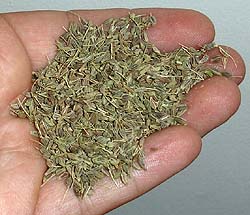| Home A B C D E F G H I J K L M N O P Q R S T U V W X Y Z |
|
Home |
Anise: Benefits and Uses
References to anise date back to the sixth century BC when Pythagoras mistakenly believed that simply holding the seeds in the hand could prevent epileptic seizures. The Romans cultivated anise for its fragrance, flavor and medicinal properties. A popular Roman spice cake included anise, bay leaves and cumin. It was served after heavy meals, especially wedding feasts, and performed the dual roles of both a dessert and a digestive aid. Anise today is still widely used for its aromatic, culinary and medicinal qualities. The spice has traditionally been used in protection and meditation incenses. It is supposed to ward off evil and sleeping on a pillow containing aniseeds will prevent nightmares. A sprig of anise hung on the bedpost will reputedly revive departed youth. 
Anise is native to the Eastern Mediterranean and, although an annual, it is not easy to grow in northern climes because it requires a soil temperature of 70 degrees F. (21 degrees C) to germinate and a long, hot summer for the seeds to ripen. It also has a long taproot, which makes transplanting difficult, so it’s best grown from seed. Coriander makes a good companion plant, improving the seed formation on anise, which prefers full sun in well-drained alkaline soil. The plant is quite fragile and needs protection from strong winds. Once growing, thin the anise plants to a distance of half a metre and keep them watered during hot, dry weather. Due to the presence of the compound anethole, aniseeds are an effective reliever of gas, bloating and indigestion, which is why they are often served after a meal, particularly in Asian restaurants. Throughout the Mediterranean, anise based liqueurs – ouzo in Greece, pastis in France, sambuca in Italy and anisette in Spain – are served as after dinner drinks. However, a cup of anise tea is a refreshing way to cleanse the palate and settle the stomach after a heavy meal without the added calories and alcohol of a liqueur. Aniseeds are also customarily given to children to relieve colic and nausea. The antispasmodic properties of the seeds make them helpful in countering menstrual pain, asthma, bronchitis and spasmodic coughs such as whooping coughs. Anise is an effective expectorant. It contains the compounds creosol and alpha-pinene, which have been shown to loosen mucus in the bronchial tubes. For flatulent colic aniseeds may be combined with equal amounts of fennel and caraway. For bronchitis it mixes well with coltsfoot, white horehound and lobelia. Anise also contains the compounds dianethole and photoanethole, which are chemically similar to the female hormone estrogen. For this reason traditional herbalists have often recommended the spice for promoting milk production in nursing mothers and for relieving menopausal hot flashes. In both instances three cups of anise tea per day is advocated. It is best to buy the whole seed for culinary use – and grind it yourself as needed – as already ground aniseed quickly loses its flavor and aroma. Store the seeds in airtight containers away from sunlight. If you notice that the seeds are turning brown, they are going stale and should be discarded. Aniseeds are used to flavor cakes, breads, eggs, fruit and cheese. In Mediterranean cuisine, anise is used in meat and vegetable dishes. In savory dishes it is interchangeable with fennel for flavoring soups, sauces, fish and poultry dishes. Don’t confuse anise with star anise, a star-shaped fruit that grows as an evergreen bush in China. The essential oil of star anise has a similar, but harsher, taste to anise and is preferred in Asian cooking. The milder flavor of anise is the choice of western cuisine. Here’s a healthy recipe for breakfast oatcakes using the spice: Anise Oatcakes: · Two cups of milk (coconut or nut milk may be substituted); In a large bowl mix the soymilk, oatmeal, orange zest and aniseed. Set aside for 15 minutes to soften the oatmeal. If prepared ahead of time, store the mixture in the refrigerator. Beat the eggs and then add the brown sugar and one tsp. of the oil while still whisking. In a separate bowl, sift the dry ingredients together and then stir into the batter. Heat the other three teaspoons of oil in a nonstick pan over a medium-high heat. Ladle the batter into the pan, keeping about an inch of space between the pancakes. Flip once only when the top becomes bubbly. Serve with a warm berry sauce, such as blueberries. The following Anise Cookies are delicious, but are poor keepers and need to be consumed quickly. · 1 cup of whole wheat flour Preheat the oven to 400 degrees F. Oil lightly two cookie sheets. Cream together the butter and sugar. Add the eggs, vanilla and anisette extract and mix thoroughly. In another bowl, mix the dry ingredients. Slowly fold the dry mixture into the wet until you have smooth dough. Drop one teaspoon of the dough at a time on to the cookie sheet. Bake for about six to eight minutes or until golden brown. This recipe will make about 36 cookies. Bruce Burnett is a Chartered Herbalist, an award-winning writer and author of the best-selling book HerbWise: growing cooking wellbeing. Contact Bruce through his website: http://www.herbalcuisine.com |
||
|
|
||
|
Glossary References Links Contact
|